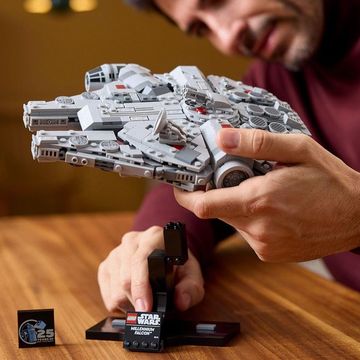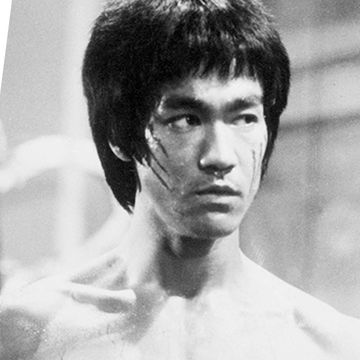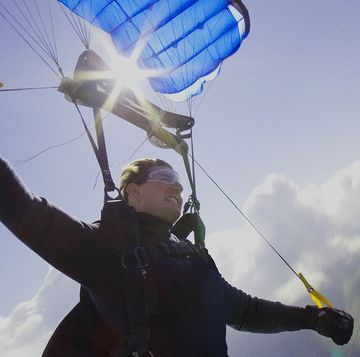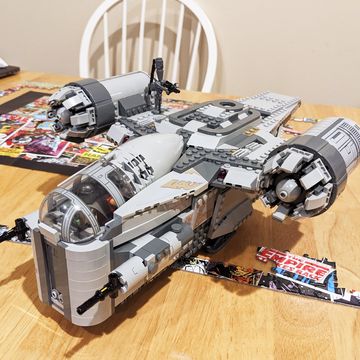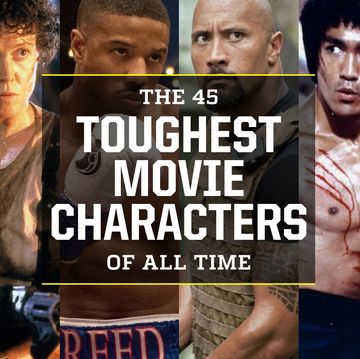1. Sound artists used real-life animal sounds for Pandora's beasts.
Skywalker Sound was responsible for crafting not only the ambient noise of Pandora, but also its many strange creatures. "A lot of the mandates that we got from Jim were specific sounds for specific creatures," says Juan Peralta, who heads up postproduction sound at Skywalker and worked closely with Avatar's sound designer, Christopher Boyce. "He wanted three vocalizations for the viper wolf, a six-legged, dog-like creature: one for stalking their prey, another when they're chasing the prey—so that they can call to other viper wolves for help—and a third during attack." The viper wolf vocalizations came from hyenas and coyotes; much of Pandora's ambient sound came from recordings taken in Costa Rica and Africa. The sound was originally mixed in 5.1, which will be preserved on the Blu-ray.
2. Every Na'vi costume was built in real life.
The Na'vi never existed outside the virtual world, but their clothes were a different story. "By the time I came into the project, it was pretty well-established what the world would be and the people would be," says costume designer Deborah Scott, who also worked on Back to the Future, E.T. and Titanic. "It was just sort of a blank space on how the costumes were going to be accomplished." Though the garment designs were simple, they incorporated many different fabrics and textiles. "The animators really needed to have an actual 3D textured piece to make it look as real as it looks in the movie because of the nature of the design and the complicated weavings and the textures of the beads and feathers," Scott says. Making the costumes in real life also gave animators a reference for how feathers would blow in the wind. "Even though the garments are simple, there's a lot of movement in them," Scott says.
3. James Horner invented many of the instruments used in the movie's score.
Composer James Horner was faced with an interesting challenge when crafting Avatar's score: It had to incorporate instruments that weren't familiar. "It's amazing how many sounds sound like instruments from other countries," Horner says. "I'd make a sound and even though it was made especially for the film, it sounded like something you might have heard, like some Iranian instrument," Horner says. "And I would find a flute that sounded lovely, but it sounded like a Chinese flute or some weird bagpipe from the Scandinavian countries." Horner ended up creating most of the instruments' sounds on the computer; they were then played through keyboards, percussion and wind instruments. "We had to create a whole world of sounds that Jim would buy off on," Horner says.
[youtube]http://www.youtube.com/v/nTtBXpw8db4?fs=1&hl=en_US[/youtube]
4. Cars factored into Cameron's creature design.
When they got together at his house in May 2005, Cameron relayed a thought about Pandora's beasts to lead creature designer Neville Page: racing stripes. "We started to develop this notion of using automotive lines and form language in the creatures," Page says. That form can be seen particularly in the banshee: "It actually has a through line that runs from its chin through its zygomatic arch down its jugular, through its body and ends at the tip of the tail," Page says. "And that was an extremely helpful cue to develop the creatures, particularly the ones that would be aerodynamic."
5. Cameron used two different 3D camera rigs to shoot Avatar.
Cameron and collaborator Vincent Pace have been working to develop quality 3D camera technology for years. "Some of the techniques that he used for 2D couldn't be compromised: steady cam, handheld," Pace says of that process. "Anything that he wanted to do and accomplish in 2D would be the same if he was going to introduce 3D." The first rig they developed used Sony F-950 cameras and mimicked human eyes: two lenses, side by side, held in a static position approximately 2 inches apart. "The problem with that system is that as you get closer to it, you're starting to see more in one eye because of the proximity," Pace says. "Taken to the extreme, for instance, you can only see my finger in one lens and not in the other." The duo developed a beam- splitter ray that allowed the lenses of two cameras to overlap each other and create dynamic interocular distance. "Now I'm not restricted by my interocular distance," Pace says. "In fact, I can bring it all the way down to zero if I want to by making the adjustment." Cameron used this more advanced system to shoot about 80 percent of the film; the first rig was used about 20 percent of the time (Pace says that percentage is reversed when the rigs are used to film sports).
>
The Na'vi Language, Heavy Weapons
And Digital Performances >>>
6. Visual-effects artists used a facial mold with holes in it to place the green dots on the actors' faces.
In order to track the actors' facial movements—which they would later use to turn the actors into their Na'vi counterparts—Avatar's visual-effects department needed to place green dots along the primary facial muscles, which were captured by a unique camera rig that sat a few inches from the actors' faces. "As the actor delivered dialogue or emoted in some way, we could track the position of the dots from frame to frame," says senior VFX supervisor Joe Letteri. "We could understand, via solving algorithm, how those should apply to virtual armature in Neytiri's face. So we're taking [Zoe Saldana's] facial performance and mapping it onto Neytiri's model." But rather than applying [the dots] painstakingly by hand, they used masks of the actors' faces that had holes bored where the dots needed to be. "Every morning Zoe would come in and we'd put this mask on her face," says Stephen Rosenbaum, visual-effects supervisor at Weta Digital, which created the effects. "In just 10 minutes, we could plot the dots there and paint her up and send her on the stage." In addition to saving the production tons of time, the mask made maintaining the dots over the course of the day much easier.
7. In the climactic banshee flight sequence, the choir is singing in Na'vi.
Paul Frommer, who created the Na'vi language, wrote words about flight for Horner to use in the sequence where Jake tames a banshee—and takes it for a ride. "Not any prose, not any Na'vi poetry," Horner says. "They're all to do with flight and race and air and wind, but there's no continuity to it. I just used them abstractly, like painting. Paul wrote about an extra 60 words for me for this sequence."
8. Na'vi was influenced by Amharic, Persian and Chinese, among other languages.
Paul Frommer first got the call to create a language for Avatar in 2005. "It's been pandemonium ever since," says the USC linguistics professor, who based the sound of the language on ejectives. "They're kind of hopping sounds," he says. "There are three of them in Na'vi." Ejectives are found in real languages, like Amharic, the national language of Ethiopia. Na'vi also contains sounds found in certain indigenous languages of America and Central Asia. "Certain languages that by coincidence I happen to be familiar with influenced the language in various ways," Frommer says. "There's something grammatically that looks a little bit like Persian, something that looks a little bit like Chinese or Hebrew or Indonesian. But the combination is unique."
Right now, there are 1400 words; English, by comparison, has nearly 40,000. But Frommer is working on the language all the time, and fans are even teaching themselves to speak and write in Na'vi. The professor never wanted to make the language easy to master. "I wanted it to be a challenge," Frommer says, "but not impossible. And so people have been able to rise to the occasion."
[youtube]http://www.youtube.com/v/V73gkzSjek0?fs=1&hl=en_US[/youtube]
9. Cameron enlisted a botanist to consult on the production.
Grace, played by Sigourney Weaver, is a botanist who is trying to unravel the mysteries of Pandora's wildly exotic and varied plant life. Cameron asked Jodie Holt, a professor in the department of botany and plant sciences at the University of California, Riverside, to advise Weaver not only on what a botanist who goes out in the field would carry, but how she would collect samples and even what she would wear.
Holt also gave the film some scientific clout, suggesting that Cameron use signal transduction to explain how Pandora's plants communicate. "It's a very credible process that explains how organisms have communication among cells or from cells over long distances," Holt says. "We know enough about it to say it could work, and it could explain what's in the movie." And after production was completed, Holt was asked to come up with botanical descriptions for the plants on Pandora, which appear not only in the Pandorapedia on the Blu-ray, but also in the Avatar game.
10. Editing of Avatar happened as the movie was being filmed.
How do you cut together a film that will eventually be almost entirely virtual but is derived from live-action performances? "Our department was involved very early on, in kind of a pre-postproduction process where we would edit the performances," says editor John Refoua. He and fellow editor Stephen Rivkin looked at all the live-action footage shot on the Volume and edited the various takes together into what they called a performance edit. "We cut in different takes derived from four reference cameras that were a record of what was captured," Rivkin says. "It's not necessarily the angles that will be in the film or the cut points. But we have to start somewhere to see if we have the performance we want." The editors used a complex color-coded system to keep track of where each shot came from. When Cameron would sign off on those performances, the files were sent to Weta, which would play them back (sometimes months later) to create the virtual shots that made the film.
11. The futuristic weapons in Avatar were props, but just barely.
The weapons the invading Marines carried in Avatar couldn't be your typical military machinery rented from a prop house—the AMP suit is proof enough of that. "Jim wants to give the actors stuff to work with," says John Rosengrant of Legacy Effects, which built the weapons for the film. "Weta had done a lot of the concept work of the guns and various other props, grenades, phones. If you didn't know, you would think they were real." The weapons even have realistic-looking heft and details. "This grenade is not just the shape of something that is viable," Rosengrant says. "Its weight, the tactility of the different materials... it's got a certain sheath on the outside—it feels like a real product, with a real pin and real graphics. This is a testament to how thorough Jim is and how thorough Weta is at execution. Everything was thought out quite thoroughly during this movie, every detail."

